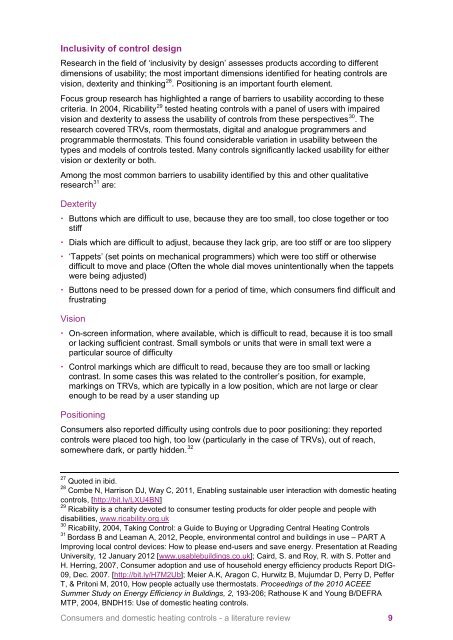Consumers-and-domestic-heating-controls-a-literature-review
Consumers-and-domestic-heating-controls-a-literature-review
Consumers-and-domestic-heating-controls-a-literature-review
You also want an ePaper? Increase the reach of your titles
YUMPU automatically turns print PDFs into web optimized ePapers that Google loves.
Inclusivity of control design<br />
Research in the field of ‘inclusivity by design’ assesses products according to different<br />
dimensions of usability; the most important dimensions identified for <strong>heating</strong> <strong>controls</strong> are<br />
vision, dexterity <strong>and</strong> thinking 28<br />
. Positioning is an important fourth element.<br />
Focus group research has highlighted a range of barriers to usability according to these<br />
29<br />
criteria. In 2004, Ricability tested <strong>heating</strong> <strong>controls</strong> with a panel of users with impaired<br />
vision <strong>and</strong> dexterity to assess the usability of <strong>controls</strong> from these perspectives 30<br />
. The<br />
research covered TRVs, room thermostats, digital <strong>and</strong> analogue programmers <strong>and</strong><br />
programmable thermostats. This found considerable variation in usability between the<br />
types <strong>and</strong> models of <strong>controls</strong> tested. Many <strong>controls</strong> significantly lacked usability for either<br />
vision or dexterity or both.<br />
Among the most common barriers to usability identified by this <strong>and</strong> other qualitative<br />
31<br />
research are:<br />
Dexterity<br />
� Buttons which are difficult to use, because they are too small, too close together or too<br />
stiff<br />
� Dials which are difficult to adjust, because they lack grip, are too stiff or are too slippery<br />
� ‘Tappets’ (set points on mechanical programmers) which were too stiff or otherwise<br />
difficult to move <strong>and</strong> place (Often the whole dial moves unintentionally when the tappets<br />
were being adjusted)<br />
� Buttons need to be pressed down for a period of time, which consumers find difficult <strong>and</strong><br />
frustrating<br />
Vision<br />
� On-screen information, where available, which is difficult to read, because it is too small<br />
or lacking sufficient contrast. Small symbols or units that were in small text were a<br />
particular source of difficulty<br />
� Control markings which are difficult to read, because they are too small or lacking<br />
contrast. In some cases this was related to the controller’s position, for example,<br />
markings on TRVs, which are typically in a low position, which are not large or clear<br />
enough to be read by a user st<strong>and</strong>ing up<br />
Positioning<br />
<strong>Consumers</strong> also reported difficulty using <strong>controls</strong> due to poor positioning: they reported<br />
<strong>controls</strong> were placed too high, too low (particularly in the case of TRVs), out of reach,<br />
somewhere dark, or partly hidden. 32<br />
27 Quoted in ibid.<br />
28 Combe N, Harrison DJ, Way C, 2011, Enabling sustainable user interaction with <strong>domestic</strong> <strong>heating</strong><br />
<strong>controls</strong>, [http://bit.ly/LXU4BN]<br />
29 Ricability is a charity devoted to consumer testing products for older people <strong>and</strong> people with<br />
disabilities, www.ricability.org.uk<br />
30 Ricability, 2004, Taking Control: a Guide to Buying or Upgrading Central Heating Controls<br />
31 Bordass B <strong>and</strong> Leaman A, 2012, People, environmental control <strong>and</strong> buildings in use – PART A<br />
Improving local control devices: How to please end-users <strong>and</strong> save energy. Presentation at Reading<br />
University, 12 January 2012 [www.usablebuildings.co.uk]; Caird, S. <strong>and</strong> Roy, R. with S. Potter <strong>and</strong><br />
H. Herring, 2007, Consumer adoption <strong>and</strong> use of household energy efficiency products Report DIG-<br />
09, Dec. 2007. [http://bit.ly/H7M2Ub]; Meier A.K, Aragon C, Hurwitz B, Mujumdar D, Perry D, Peffer<br />
T, & Pritoni M, 2010, How people actually use thermostats. Proceedings of the 2010 ACEEE<br />
Summer Study on Energy Efficiency in Buildings, 2, 193-206; Rathouse K <strong>and</strong> Young B/DEFRA<br />
MTP, 2004, BNDH15: Use of <strong>domestic</strong> <strong>heating</strong> <strong>controls</strong>.<br />
<strong>Consumers</strong> <strong>and</strong> <strong>domestic</strong> <strong>heating</strong> <strong>controls</strong> - a <strong>literature</strong> <strong>review</strong> 9


